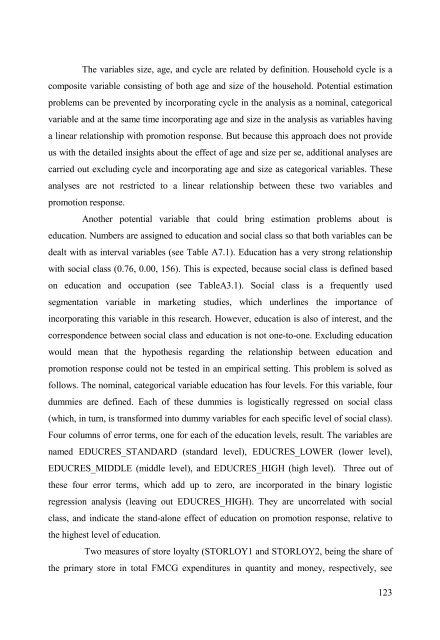Analysis of Sales Promotion Effects on Household Purchase Behavior
Analysis of Sales Promotion Effects on Household Purchase Behavior
Analysis of Sales Promotion Effects on Household Purchase Behavior
You also want an ePaper? Increase the reach of your titles
YUMPU automatically turns print PDFs into web optimized ePapers that Google loves.
The variables size, age, and cycle are related by definiti<strong>on</strong>. <strong>Household</strong> cycle is a<br />
composite variable c<strong>on</strong>sisting <str<strong>on</strong>g>of</str<strong>on</strong>g> both age and size <str<strong>on</strong>g>of</str<strong>on</strong>g> the household. Potential estimati<strong>on</strong><br />
problems can be prevented by incorporating cycle in the analysis as a nominal, categorical<br />
variable and at the same time incorporating age and size in the analysis as variables having<br />
a linear relati<strong>on</strong>ship with promoti<strong>on</strong> resp<strong>on</strong>se. But because this approach does not provide<br />
us with the detailed insights about the effect <str<strong>on</strong>g>of</str<strong>on</strong>g> age and size per se, additi<strong>on</strong>al analyses are<br />
carried out excluding cycle and incorporating age and size as categorical variables. These<br />
analyses are not restricted to a linear relati<strong>on</strong>ship between these two variables and<br />
promoti<strong>on</strong> resp<strong>on</strong>se.<br />
Another potential variable that could bring estimati<strong>on</strong> problems about is<br />
educati<strong>on</strong>. Numbers are assigned to educati<strong>on</strong> and social class so that both variables can be<br />
dealt with as interval variables (see Table A7.1). Educati<strong>on</strong> has a very str<strong>on</strong>g relati<strong>on</strong>ship<br />
with social class (0.76, 0.00, 156). This is expected, because social class is defined based<br />
<strong>on</strong> educati<strong>on</strong> and occupati<strong>on</strong> (see TableA3.1). Social class is a frequently used<br />
segmentati<strong>on</strong> variable in marketing studies, which underlines the importance <str<strong>on</strong>g>of</str<strong>on</strong>g><br />
incorporating this variable in this research. However, educati<strong>on</strong> is also <str<strong>on</strong>g>of</str<strong>on</strong>g> interest, and the<br />
corresp<strong>on</strong>dence between social class and educati<strong>on</strong> is not <strong>on</strong>e-to-<strong>on</strong>e. Excluding educati<strong>on</strong><br />
would mean that the hypothesis regarding the relati<strong>on</strong>ship between educati<strong>on</strong> and<br />
promoti<strong>on</strong> resp<strong>on</strong>se could not be tested in an empirical setting. This problem is solved as<br />
follows. The nominal, categorical variable educati<strong>on</strong> has four levels. For this variable, four<br />
dummies are defined. Each <str<strong>on</strong>g>of</str<strong>on</strong>g> these dummies is logistically regressed <strong>on</strong> social class<br />
(which, in turn, is transformed into dummy variables for each specific level <str<strong>on</strong>g>of</str<strong>on</strong>g> social class).<br />
Four columns <str<strong>on</strong>g>of</str<strong>on</strong>g> error terms, <strong>on</strong>e for each <str<strong>on</strong>g>of</str<strong>on</strong>g> the educati<strong>on</strong> levels, result. The variables are<br />
named EDUCRES_STANDARD (standard level), EDUCRES_LOWER (lower level),<br />
EDUCRES_MIDDLE (middle level), and EDUCRES_HIGH (high level). Three out <str<strong>on</strong>g>of</str<strong>on</strong>g><br />
these four error terms, which add up to zero, are incorporated in the binary logistic<br />
regressi<strong>on</strong> analysis (leaving out EDUCRES_HIGH). They are uncorrelated with social<br />
class, and indicate the stand-al<strong>on</strong>e effect <str<strong>on</strong>g>of</str<strong>on</strong>g> educati<strong>on</strong> <strong>on</strong> promoti<strong>on</strong> resp<strong>on</strong>se, relative to<br />
the highest level <str<strong>on</strong>g>of</str<strong>on</strong>g> educati<strong>on</strong>.<br />
Two measures <str<strong>on</strong>g>of</str<strong>on</strong>g> store loyalty (STORLOY1 and STORLOY2, being the share <str<strong>on</strong>g>of</str<strong>on</strong>g><br />
the primary store in total FMCG expenditures in quantity and m<strong>on</strong>ey, respectively, see<br />
123

















